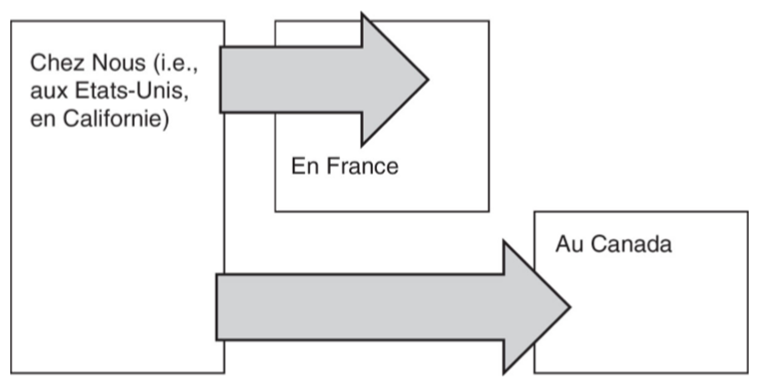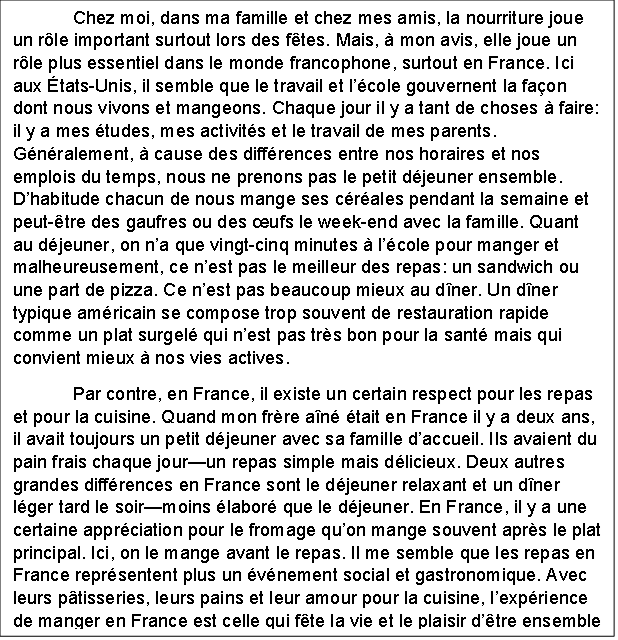Chapter 7: Cultural Comparisons
A. Instructions, Strategies, and Tips
What Will Actually Happen?
You will have 4 minutes to read the question, organize your thoughts, and prepare your presentation. Jot down some ideas that will assist you when it is time to speak.
Do not attempt to write a script. Instead, prepare a short outline or a list of key terms that will serve as reminders as you speak.
Then you will have 2 minutes to record your presentation.
The presentational speaking task will test your ability to speak about a specific topic.
Do not hesitate to mention how and where you acquired your information.
You need to show what you know about French and francophone cultures.
Manage your time.
Remember to use the appropriate forms of address (vous forms).
Use effective stylistic devices as you are speaking to your class.
As the task requires you to make a comparison, be sure to include the following in your presentation:
Your own community (as narrow as your family or as wide as your country)
A francophone culture you know well and include examples and detailed support
Differences and similarities between your community as you have defined it and the francophone culture you have chosen to discuss
Remember the Following Strategies and Tips
Planning Phase
There is no source material for this task—only a promp
Read the prompt carefully. Underline key words.
Do not confuse the general directions for this task (comparing cultures) with the specific prompt for this task (focusing on a precise aspect of culture such as people’s attitude toward cultural diversity).
Relate the topic to your own experience and knowledge of cultures.
Take notes to organize your oral presentation during the 4 minutes before you record your voice. Use a graphic organizer such as a Venn diagram to identify similarities and differences.
You do not need numerous examples. One well-developed example on each side might be sufficient as long as you elaborate and show insight into the reasons for the differences.
Write a thesis statement that clearly demonstrates an understanding of the topic and task and that will introduce your presentation.
Map out your oral presentation using key words and phrases to provide significant and specific examples (products, perspectives, practices) in your own culture as well as in a francophone culture to support the thesis statement.
Do a significant number of practice items to be comfortable using the 2minute time allotment fully and efficiently.
If you answer the prompt fully, it is likely that you will be stopped midsentence by the beep that signals the end of the 2-minute session. The beep does not mean that your score is penalized.
Presentational Phase
You have 2 minutes to make an oral presentation on a specific topic related to one of the six course themes.Your first goal in speaking French is to make yourself clearly understood. A more varied and precise vocabulary (including idiomatic expressions and transitional words) and a more varied use of grammatical structures will enhance your performance and your score.
You are making this presentation to your class; in addressing your audience, use the plural vous and the formal register required in an academic setting (no slang).
Use your thesis statement to introduce the topic and give a concise outline of your presentation.
Present your ideas in an organized manner, using your outline.
Describe and narrate precise observations and experiences you have had in your own community (family, school, neighborhood, town, region, state, or country) within the context of the task (which requires you to focus on a specific aspect of culture).
Try to accurately reference materials you have studied as well as personal observations and life experiences that are relevant to the topic and to the French-speaking world.
Compare and contrast products, perspectives, and practices in your own community and the francophone region of your choice, avoiding generalizations and stereotypes as much as possible.
B. Useful Vocabulary for a Comparison
To Start Your Conversation
Tout d’abord First of all
En premier lieu First of all
Pour commencer To start off with
Premièrement Firstly
To State Your Opinion/Point of View
À mon avis In my opinion
Selon moi In my opinion
Pour ma part As far as I’m concerned
En ce qui me concerne As far as I’m concerned
A mon sens As I see it
Il me semble que It seems to me that (+ indicative mood)
J’estime que I consider that
Je soutiens que I maintain that
To Add/Connect Ideas
Ensuite Next
De plus In addition
En outre Furthermore
En deuxième lieu Secondly
To Show a Difference in Opinion or a Contrast
Mais But
En fait In fact
Cependant However
Toutefois However
Au contraire On the contrary
Par contre By contrast
Néanmoin Nevertheless
Quand même Nevertheless
Pourtant Yet
To Conclude
En dernier lieu Lastly
Enfin Finally**.**
Pour terminer To finish up with
Pour finir To finish up with
Tout bien réfléchi All in all
Tout bien considéré All in all
Tout compte fait When all is said and done
Toute réflexion faite When all is said and done
En somme In short, all in all
En fin de compte When all is said and done, at the end of the day
En conclusion To conclude/in conclusion
Pour conclure To conclude/in conclusion
C. Instructions and Examples
Below are the types of instructions you may receive on the exam:
This part requires spoken responses. Your cue to start or stop speaking will always be this tone. | Cette partie exige des réponses orales Votre signal pour commencer ou arrête de parler sera toujours cette tonalité. |
|---|
You have 1 minute to read the directions for this part. | Vous avez 1 minute pour lire les instructions de cette partie. |
|---|
Your spoken responses will be recorded. Your score will be based on what you record. It is important that you speak loudly enough and clearly enough for the machine to record what you say. You will be asked to start, pause, and stop your recorder at various points during the exam. Follow the directions and start, pause, or stop the recorder only when you are told to do so. Remember that the tone is a cue only to start or stop speaking— not to start or stop the recorder. | Vos réponses seront enregistrées. Votre note sera basée sur ce que vous aurez enregistré. Il est important que vous parliez assez fort pour que vos réponse soient enregistrées. Il vous sera deman de mettre en marche, de mettre en paus et d’arrêter l’appareil à certains mome de l’examen. Suivez les instructions et mettez en marche, mettez en pause ou arrêtez l’appareil seulement quand on vous le dira. Rappelez-vous que la tonalité est seulement le signal pour commencer ou arrêter de parler—pas pour mettre en marche ou arrêter l’appareil. |
|---|
You will now begin this part. | Vous allez maintenant commencer cette partie. |
|---|
You will make an oral presentation on a specific topic to your class. You will have 4 minutes to read the presentation topic and prepare your presentation. Then you will have 2 minutes to record your presentation. In your presentation, compare a French-speaking community with which you are familiar to your own or another community. You should demonstrate your understanding of cultural features of this French-speaking community. You should also organize your presentation clearly. | Vous allez faire un exposé pour votre classe sur un sujet précis. Vous aurez 4 minutes pour lire le sujet de cet exposé préparer votre exposé. Vous aurez alor minutes pour vous enregistrer. Dans votre exposé, comparez une région du monde francophone que vou connaissez à votre propre communauté à une autre communauté. Vous devez démontrer votre compréhension de réalités culturelles de cette communau francophone. Vous devez aussi organis clairement votre exposé. |
|---|
Model Prompt #1
Thème du cours: Esthétiq
Quelle est l’attitude des gens que vous connaissez bien chez vous concernant l’importance de la nourriture et des repas? Comparez-la avec ce qui se passe dans un endroit du monde francophone.
This question asks you to compare the role played by food and meals in the area where you live as compared with an area in the French-speaking world.

Chez Nous | En France | Au Canada |
|---|---|---|
Un petit déjeuner rapide Un déjeuner qui dure moins d’une heure Un dîner qui a lieu assez tôt Une cuisine influencée par les immigrés du 20ième siècle Une grande quantité de fast food ou de restauration rapide | Seulement du pain-beurre- confiture et du jus ou du café Un déjeuner qui peut durer deux heures et qui est souvent en famille Un dîner assez tard le soir Une cuisine variée accompagnée de fromages et de vins La cuisine est considérée comme un art | Des plats copieux Une cuisine nordaméricaine La bière accompagne souvent les repas |
Presentation #1 (Transcript)
This is the text of a 2-minute exemplary oral presentation that responds to the example question.

Facts You Should Know
First look at each prompt and ask yourself what specific examples come to mind regarding the aspect of culture described in the prompt.
You only need to deepen your understanding of the cultural aspect to be discussed in one of these francophone cultures.
Remember that your examples may come from personal experience but may also be based on articles, novels, newscasts, and so on.
There are many topics can be linked to several of the six themes in the AP French Language and Culture course and exam. However, remember that the prompt for the oral presentation on your AP exam will be linked to a single theme.
 Knowt
Knowt
